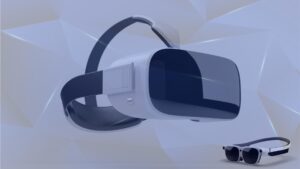This may sound like a dystopian science-fiction future, but the development of sophisticated machine learning algorithms will eventually enable silicon chips to replace living things just like neurons and cells in AI systems.
What we think is going to be really amazing, and we’ve already seen this with some of our chips as well, is that the same chip can be implemented in a material that has similar properties to neurons and synapses.
For example, using flexible organic materials that eventually might even be capable of communicating with biological neurons, scientists are attempting to replicate the extraordinary capability of the human brain, which can process and store information a thousand times faster than the fastest supercomputer.
In the future, silicon chips will be able to imitate living biological systems to such an extent that AI systems will be capable of generating human-like intelligence and even consciousness.
When we are able to train a silicon-based life to see, speak, hear, and generate human-like emotions, it is also likely to be programmed to become self-aware and use its intelligence to design more powerful chips that will enable it to think even faster.
Then the real race for silicon will begin.
How can silicon chips replace living things?
Silicon, a tetravalent nonmetallic element that is combined to form the second-most abundant element in the earth’s crust after oxygen, is perfect for this task because it can be programmed to imitate all of a living system’s functions.
On the periodic table, silicon comes below carbon. It can also form four covalent bonds with its four adjacent atoms. And for this reason, silicon may be used to make complex molecules just as easily.
Akin to the biological neural network in the human body, artificial neural networks can even make decisions without the original biological input.
When researchers made living cells from carbon-silicon bonds in 2016, it proved for the first time ever that nature could include silicon into the building blocks of life. This further showed that carbon traces might not be the only signs of life we should be looking for.
Based on the same discovery, scientists believe that understanding silicon-based life has the potential not only to replace living things on Earth but also to be a missing piece in other parts of the universe.
The next evolutionary step of silicon-based life is therefore to create artificial neural networks similar to those found in biological systems.
General procedure and probability
By going through a sophisticated procedure to generate silicon chips, engineers basically look into this technology, intended to stand in the place of living things, by using biological simulators on silicon-based neural networks.
In 2019, a team from the University of Bath has been able to get silicon neurons to replicate the function of a human brain system, which means that these silicon chips will one day be capable of mimicking the human brain and its functions. Scientists then made artificial nerve cells, paving the way for new ways to repair the human body.
The tiny “brain chips” behaved like the real thing, and the chip design had to come up with a way to replicate in circuit form what nerve cells (neurons) do naturally. For example, neurons “carried signals” to and from the brain and the rest of the body.
The research necessarily does not stop just at the point of making artificial nerve cells. On the basis of ongoing research on the topic, the use of silicon in creating silicon-based living things can be comprehensively enhanced even further, showing the initial results probably in the very near future.
Debates on silicon-based life system
Scientists have been debating the prospects of the issue along with the first scientific proposal for silicon-based life, which extends back to the ideas of German astrophysicist Julius Scheiner in 1891.
However, as a team of MIT astrobiologists recently pointed out, no one has systematically and comprehensively assessed silicon’s capacity to support life in both a terrestrial environment and plausible non-terrestrial settings. They tackled this problem in a 2020 review article published in the journal Life in which they presented a detailed evaluation of silicon’s life-support capacity.
The team from MIT noted that any life-supporting chemical element must display sufficient chemical diversity. This chemical diversity is required to produce the chemical complexity necessary to generate the diverse collection of molecular structures and chemical operations required to originate and sustain living systems.
One argument for why silicon chips will start replacing living things sooner rather than later may be that “silicon is better than carbon.” Silicon shares a number of similarities with carbon, particularly in the way they combine with other elements to form complex molecules. However, silicon bonds strongly with oxygen, and in many cases, silicon compounds have higher melting points than their carbon counterparts.
For example, silicon-oxygen bonds can withstand temperatures as high as ~600 K and silicon-aluminum bonds at nearly 900 K. But, carbon bonding of any type breaks down at such high temperatures, making carbon-based life impossible.
Will silicon-based life be better?
Silicon-based living things will invariably be better than living things that are currently on Earth. The new life forms will be able to tolerate much higher levels of radiation than even the hardest rocks on earth. Also, silicon as an element is incredibly stable as it does not form reactive bonds with other solids at ordinary pressures and temperatures.
If we compare this fact with the chemical diversity of silicon and regard it as an essential requirement for silicon-based life, it could lead to the conclusion that silicon must be capable of producing a large spectrum of living systems containing hundreds of thousands of chemical species.
The MIT discovery is extremely important for mankind because, consequently, silicon has to acquire the necessary living system characteristics to ultimately play a crucial role in the development of artificial intelligence and in the creation of an entirely new line of life.
When silicon chips replace living things completely or even partially, we will start seeing that everything we know now can no longer be considered human. Like simulated neurons AI systems, silicon-based life will be interconnected, that with artificial intelligence underpinning everything.
Silicon can form a huge number of possible compounds, which are not found in the carbon world, and this will produce a very rare form of super life.
The ‘now’ is pointing towards the “same”.
- Researchers use AI to make Belgian beer taste better - March 27, 2024
- Researchers introduce RAmBLA as a holistic approach to evaluating biomedical language models - March 26, 2024
- Smart tattoos that monitor health metrics and vital signs - March 25, 2024



